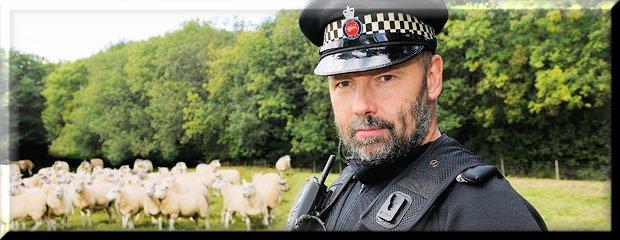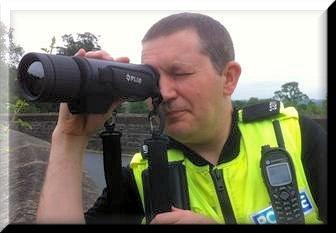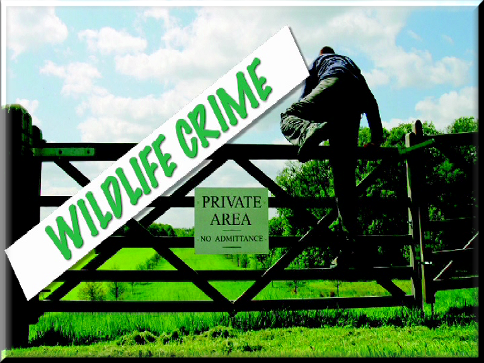
Ferreting And The Law!

ARE YOU BEING WATCHED ?

STAY ABOVE THE LAW AND STAY LEGAL
The laws on the following pages are designed to be of help when ferreting or looking to gain ferreting permission and can be used as an excellent bargaining point or dropped into a conversation to give the impression of professionalism. The laws not only affect what and how we hunt but also how we treat animals in general, whether it is the rabbit, dog or ferret. Remember, that whilst you are out ferreting or looking to gain new permission, it is the whole of the ferreting community you are representing and not just yourself.
Firearms legalisation:
All guns used in connection with ferreting must comply with the relevant firearms law and must be held on the relevant firearm or shotgun certificates.
The Ground Game Act 1880
This gives every occupier of land a limited right to kill and take rabbits and hares concurrently with the right of any other person entitled to do so on the same land. An occupier may use any legal method to kill rabbits, such as gassing, trapping, ferreting, shooting, snaring, netting, and, with the exception of shooting, he may authorise other persons to assist him. The Ground Game Act exempts an occupier, and persons authorised by him to kill rabbits, from the need to hold a game licence. There is no close season for rabbits or prohibited time of taking with the exception of the provisions of the Ground Game Act 1880 and 1906, relating to the taking of rabbits on moorland and on unenclosed land.
Protection of animals Act 1911
This Act protects animals from suffering any form of cruelty.
Agriculture Act 1947
Under section 98 any person having the right to do so may, by written notice, be required by the minister to take such steps as may be necessary for the killing, taking or destruction of certain animals or birds (or their eggs) for the purpose of preventing damage to crops, pasture, animal or human foodstuffs, livestock, trees, hedges, banks or any works of land. The notice may specify time limits for any action, the steps to be taken and the land on which they are to be taken.
Animals that may be specified in the notice are rabbits, hares, other rodents, deer, foxes and moles. These are powers to add other animals to add other animals to the list. The birds that may be specified are all wild birds not protected by schedule 1 or the Wildlife and Countryside Act 1981. Under section 98(7) (added by Section 2 of the Pest Act 1954) an occupier may be required by written notice to destroy or reduce breeding places or cover (e.g. scrub) for rabbits or to prevent rabbits from spreading or doing damage elsewhere.
Under Section 99 occupiers of land may be required to take steps to prevent the escape of animals from land on which they are kept in captivity, but only if the animals are agricultural pests or animals which might damage banks or land works. Dangerous animals are not included-they are the responsibility of local authorities.
Pest Act 1954
Rabbit Clearance Orders (under section1)
Rabbit Clearance Order no. 148
Issued in 1972 made the whole of England and Wales a rabbit clearance area (excluding the city of London, the isles of Scilly and Skokholm island.)
Occupiers Responsibilities in Rabbit Clearance Area (under section 1)
All occupiers have a continuing obligation to control rabbits living on, or resorting to, their land unless they can establish that it is not reasonably practical for them to do so, when they must prevent the rabbits from doing damage, e.g. by fencing them in with rabbit-proof fencing. Local authorities have an obligation to control rabbits on their own land.
An occupier within a rabbit clearance area has unrestricted rights to kill rabbits on his land by any lawful means except by shooting.
Spread of myxomatosis (Under Section 12)
It is illegal to use an infected rabbit to spread myxomatosis.
The Abandonment of Animals Act 1960
An Act to prohibit the abandonment of animals: and for purposes connected therewith.
The 1953 Dogs (protection of livestock) Act & 1970 Animals Act
This act requires dogs and ferrets to be kept under control.
Wild Mammals (Protection) Act 1996
Under this act it is an offence to intentionally inflict unnecessary suffering, as specified by the Act, on any wild mammal. This legalisation may need to be considered where the destruction of occupied warrens and burrow systems is being contemplated. This Act plugs a loophole that existed in wildlife legislation, where non-captive wild animals had little or no protection. It made it an offence to mutilate, kick, beat, impale, stab, burn, crush, drown, drag or asphyxiate any wild animal with intent to cause unnecessary suffering. Exemptions allowed pest control and shooting to be carried out providing that the animal is killed swiftly. This eliminates drowning as a means of dispatching trapped animals.
The Specified Animal Pathogens Order 1998(S.I.1998/463)
prohibits the introduction into an animal of the live virus causing vital haemorrhagic disease (VHD) of rabbits, except where such introduction is undertaken under the authority of a license. These prohibitions mean that the deliberate spreading of myxomatosis or VHD cannot be used as a legal method of controlling rabbits.
Protection of Wild Mammals (Scotland) Act 2002
The following exemption means that it is legal to hunt rabbits with dogs on land where permission has been granted
10 Meaning of expressions
(1) In this Act “wild mammal”
1 (b) does not include a rabbit
The Hunting Act 2004
Despite what many non-rabbiting people may think, the Hunting Act 2004 did not ban the use of dogs for hunting rabbits.
Part 1 (Offences) of the act states:
1 Hunting wild mammals with dogs
A person commits an offence if he hunts a wild mammal with a dog, unless his hunting is exempt.
2 Exempt hunting
(1) Hunting is exempt if it is within a class specified in Schedule 1.
Schedule 1 (Exempt Hunting), section 4 clearly states:
The hunting of rabbits is exempt if it takes place on land,
(a) which belongs to the hunter, or
(b) which he has been given permission to use for the purpose by the occupier or, in the case of unoccupied land, by a person to whom it belongs.
You will note that there is no requirement for permission to be in writing.
S.68 CJPO Act 1994;S.5 PO Act 1986;S(1) Criminal Damages Act 1971; Breach of the peace and Common Law)
In England and Wales, where saboteurs trespass upon private land (including water, footpaths, tow paths, bridleways and byways) with the intention of disrupting, obstructing or intimidating, each saboteur commits an offence.
Firearms legalisation:
All guns used in connection with ferreting must comply with the relevant firearms law and must be held on the relevant firearm or shotgun certificates.
The Ground Game Act 1880
This gives every occupier of land a limited right to kill and take rabbits and hares concurrently with the right of any other person entitled to do so on the same land. An occupier may use any legal method to kill rabbits, such as gassing, trapping, ferreting, shooting, snaring, netting, and, with the exception of shooting, he may authorise other persons to assist him. The Ground Game Act exempts an occupier, and persons authorised by him to kill rabbits, from the need to hold a game licence. There is no close season for rabbits or prohibited time of taking with the exception of the provisions of the Ground Game Act 1880 and 1906, relating to the taking of rabbits on moorland and on unenclosed land.
Protection of animals Act 1911
This Act protects animals from suffering any form of cruelty.
Agriculture Act 1947
Under section 98 any person having the right to do so may, by written notice, be required by the minister to take such steps as may be necessary for the killing, taking or destruction of certain animals or birds (or their eggs) for the purpose of preventing damage to crops, pasture, animal or human foodstuffs, livestock, trees, hedges, banks or any works of land. The notice may specify time limits for any action, the steps to be taken and the land on which they are to be taken.
Animals that may be specified in the notice are rabbits, hares, other rodents, deer, foxes and moles. These are powers to add other animals to add other animals to the list. The birds that may be specified are all wild birds not protected by schedule 1 or the Wildlife and Countryside Act 1981. Under section 98(7) (added by Section 2 of the Pest Act 1954) an occupier may be required by written notice to destroy or reduce breeding places or cover (e.g. scrub) for rabbits or to prevent rabbits from spreading or doing damage elsewhere.
Under Section 99 occupiers of land may be required to take steps to prevent the escape of animals from land on which they are kept in captivity, but only if the animals are agricultural pests or animals which might damage banks or land works. Dangerous animals are not included-they are the responsibility of local authorities.
Pest Act 1954
Rabbit Clearance Orders (under section1)
Rabbit Clearance Order no. 148
Issued in 1972 made the whole of England and Wales a rabbit clearance area (excluding the city of London, the isles of Scilly and Skokholm island.)
Occupiers Responsibilities in Rabbit Clearance Area (under section 1)
All occupiers have a continuing obligation to control rabbits living on, or resorting to, their land unless they can establish that it is not reasonably practical for them to do so, when they must prevent the rabbits from doing damage, e.g. by fencing them in with rabbit-proof fencing. Local authorities have an obligation to control rabbits on their own land.
An occupier within a rabbit clearance area has unrestricted rights to kill rabbits on his land by any lawful means except by shooting.
Spread of myxomatosis (Under Section 12)
It is illegal to use an infected rabbit to spread myxomatosis.
The Abandonment of Animals Act 1960
An Act to prohibit the abandonment of animals: and for purposes connected therewith.
The 1953 Dogs (protection of livestock) Act & 1970 Animals Act
This act requires dogs and ferrets to be kept under control.
Wild Mammals (Protection) Act 1996
Under this act it is an offence to intentionally inflict unnecessary suffering, as specified by the Act, on any wild mammal. This legalisation may need to be considered where the destruction of occupied warrens and burrow systems is being contemplated. This Act plugs a loophole that existed in wildlife legislation, where non-captive wild animals had little or no protection. It made it an offence to mutilate, kick, beat, impale, stab, burn, crush, drown, drag or asphyxiate any wild animal with intent to cause unnecessary suffering. Exemptions allowed pest control and shooting to be carried out providing that the animal is killed swiftly. This eliminates drowning as a means of dispatching trapped animals.
The Specified Animal Pathogens Order 1998(S.I.1998/463)
prohibits the introduction into an animal of the live virus causing vital haemorrhagic disease (VHD) of rabbits, except where such introduction is undertaken under the authority of a license. These prohibitions mean that the deliberate spreading of myxomatosis or VHD cannot be used as a legal method of controlling rabbits.
Protection of Wild Mammals (Scotland) Act 2002
The following exemption means that it is legal to hunt rabbits with dogs on land where permission has been granted
10 Meaning of expressions
(1) In this Act “wild mammal”
1 (b) does not include a rabbit
The Hunting Act 2004
Despite what many non-rabbiting people may think, the Hunting Act 2004 did not ban the use of dogs for hunting rabbits.
Part 1 (Offences) of the act states:
1 Hunting wild mammals with dogs
A person commits an offence if he hunts a wild mammal with a dog, unless his hunting is exempt.
2 Exempt hunting
(1) Hunting is exempt if it is within a class specified in Schedule 1.
Schedule 1 (Exempt Hunting), section 4 clearly states:
The hunting of rabbits is exempt if it takes place on land,
(a) which belongs to the hunter, or
(b) which he has been given permission to use for the purpose by the occupier or, in the case of unoccupied land, by a person to whom it belongs.
You will note that there is no requirement for permission to be in writing.
S.68 CJPO Act 1994;S.5 PO Act 1986;S(1) Criminal Damages Act 1971; Breach of the peace and Common Law)
In England and Wales, where saboteurs trespass upon private land (including water, footpaths, tow paths, bridleways and byways) with the intention of disrupting, obstructing or intimidating, each saboteur commits an offence.

POACHING IS A CRIME !

Police Siren.mp3
© Copyright Ferreting Man's Rabbit And Vermin Control 2012